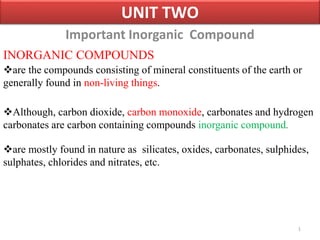
OXIDE in chemistry
- 1. Important Inorganic Compound 1 UNIT TWO INORGANIC COMPOUNDS are the compounds consisting of mineral constituents of the earth or generally found in non-living things. Although, carbon dioxide, carbon monoxide, carbonates and hydrogen carbonates are carbon containing compounds inorganic compound. are mostly found in nature as silicates, oxides, carbonates, sulphides, sulphates, chlorides and nitrates, etc.
- 2. Inorganic compounds are the compounds consisting of mineral constituents of the earth or generally found in non- living things are mostly found in nature as silicates, oxides, carbonates, sulphides, sulphates, chlorides and nitrates, etc there are different ways for the classification They can be classified on the bases of their composition 2
- 3. They can be classified on the basis of the: • metal they contain such as copper compounds, aluminium compounds, etc • non-metal they contain such as sulphurcompounds, nitrogen compounds, etc. • group they contain such as sulphates, nitrates, carbonates, etc. 3
- 4. OXIDES • Are formed when oxygen reacts directly with almost all elements except the noble gases and inactive metals like gold, platinum, and palladium. • are binary compounds containing oxygen and any other element (metal, non-metal or metalloid). • Binary compounds are those consisting of only two elements. • Examples of oxides are CaO, Al2O3, SO2, and CO. 4
- 5. CLASSIFICATION OF OXIDES INTO DIFFERENT GROUPS • they are classified based on their Chemical behaviour ACIDIC OXIDES BASIC OXIDES AMPHOTERIC OXIDES NEUTRAL OXIDES, AND PEROXIDES 5
- 6. A.ACIDIC OXIDES • are the oxides formed by the chemical combination of oxygen with non-metals. • are non-metal oxides. • are also called acid anhydrides(means acid without water). • Examples carbon dioxide, CO2, NO2, and SO2. • Note that all non-metal oxides are not necessarily acidic oxides • example, CO, and N2O,are non-metal oxides, but they are neutral oxides 6
- 7. Chemical Properties of Acidic Oxides 1. Acidic oxides (acid anhydrides) dissolve in water to form acidic solution (acid). Acid anhydride + water → Acid 2. Acidic oxides react with basic or metallic oxides to form salt. Acidic oxide + Basic oxide → Salt 3. Acidic oxides react with bases to form salt and water. This reaction is called neutralization reaction. Acidic oxide + Base → Salt + Water 7
- 8. B. BASIC OXIDES Are those that dissolve in water and react with it to form basic or alkaline solutions are called basic anhydrides There are metallic oxides which have basic properties but are insoluble in water. These oxides react with acids to give salt and water. NOTE;all metal oxides are not necessarily basic oxides; for example and ZnO are amphoteric oxides The oxides of active metals, group IA and heavier members of group IIA, dissolve in water and readily form bases 8
- 9. CHEMICAL PROPERTIES OF BASIC OXIDES 1. Basic oxides dissolve in water to form alkaline solutions. As they dissolve, they react with water to form the corresponding metal hydroxides. Basic oxide + water → Base (Alkali) 2. Basic oxides react with acidic oxides to form salts. Basic oxide + acidic oxide → salt 3. Basic oxides react with acids to form a salt and water. Basic oxide + Acid → salt + water 9
- 10. INDICATORS are substances used to identify whether a given solution is acidic or basic by showing colour changes EXAMPLE: Universal indicator and litmus paper serve as indicators Some common indicators and their colours in acidic and basic solution as follow NOTE:In addition to their effects on indicators, acidic and basic oxides can be identified by their chemical properties 10
- 11. C. AMPHOTERIC OXIDES are oxides which exhibit both acidic and basic properties In their reaction with acids, they behave as bases and, in their reaction with bases they act as acids. examples of amphoteric oxides are ZnO, PbO, PbO2, SnO, and SnO2 NOTE; acidic oxides, basic oxides and amphoteric oxides are salt- forming oxides. 11
- 12. D. NEUTRAL OXIDES are react neither with acids nor with bases to form salt and water. 12 do not show basic and acidic properties are very few in number Examples of neutral oxides are water, H2O, carbon monoxide, CO, dinitrogen monoxide, N2O, and nitrogen monoxide, NO..
- 13. E. PEROXIDES 13 • the oxidation state of oxygen in peroxides is –1 the two oxygen atoms are linked to each other and with atoms of other elements They contain the peroxide, “– O – O –” link Some examples Most peroxides of metals are formed by burning the metals in a sufficient amount of oxygen.
- 14. CHEMICAL PROPERTIES OF PEROXIDES • Some of the chemical properties of peroxides include: 14 A. Peroxides are powerful oxidizing agents; they react with different substances by losing oxygen. B. Peroxides react with aqueous acids to form hydrogen peroxide.
- 15. HYDROGEN PEROXIDE • The structure of the hydrogen peroxide molecule is: 15 decomposes to release oxygen is a strong oxidizing agent Its oxidizing power is responsible for its effectiveness as an antiseptic for mouthwash and cleansing wounds. It is also used as a bleaching agent. is added to a coloured dye, the molecule responsible for the colour will oxidize and so the colour will disappear. For example, if hydrogen peroxide is added to a black dye (paint) that contains lead sulphide, PbS, the black colour turns white. This is due to the oxidation of PbS to PbSO4. The equation for this process is: